|
|
|
||
|

|
|
Or a combo like this! Which at the first glance could look like a preamp, tuner and power amp. However, I know about no such Sherwood preamp. On the contrary. I think this is an integrated mono (stereo preamp) amplifier, tuner and a separate power amp supposed to power the second channel - a stereo retrofit, maybe? The "trannies" look extremely well-made! Sherwood had a reputation for using only the best of components.
|
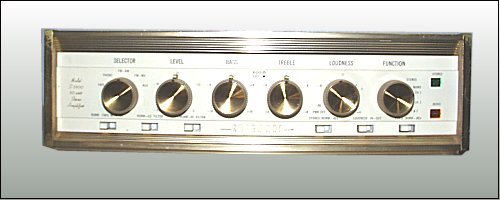
|


| Above left: Sherwood S-3000V. The Sherwood tube tuners, much like the integrated amplifiers of the same period, seems to be a splendid mix-up of designations, push-buttons, tuning scales and different facilities. I still haven't managed to figure it all out. Units with the same designations can be quite different both in logo style, number of knobs and controls and facilities. Something was going on all the time. | Above right: The S-2200. What are all those push buttons for? Are they actually push-buttons or rather adjustments for separation, muting, input sensitivity, etc.? This model also had the AM-band with separate tuning knob. (The left one) |
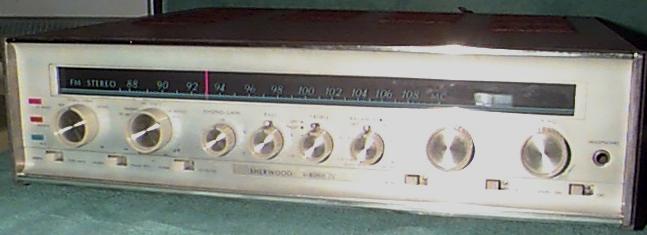 |

|
| Above: Sherwood S-8000 tube receiver. Used same output tubes as the late versions S-5000/5500, giving 2x36 watts cont. power. A much slimmer design than most of its competitors. This was made possible by slanting the mounting of tubes and capacitors. Sherwood tuners are legendary for their high sensitivity, stability and lack of noise. | The back view picture shows how Sherwood could make their units so slim. The output tubes are placed in back of the unit for best cooling, with a heat cover separating them from the rest of the unit. The bases are lowered in the chassis and the tubes slanted backwards. The heat cover, and the placement of it and the tubes, allowed a closer proximity to the unit cover |
Above pictures of S-8000 courtesy of mr. Gary Kaufman. Please look into his web-site: http://www.the-planet.org
- The AM/FM-scale can be seen clearly here. The S-2300/3300 also had automatic stereo switching. Notice the nice curve as the front bottoms out! No other brands approached the elegance of this period's Sherwoods. Just my opinion!
- Picture courtesy of Laura % Michael - scctv@cruzio.com
- Back to top.
Sherwood solid-state receivers

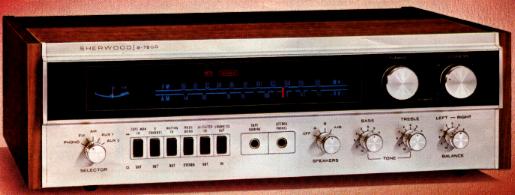
Above left: The S-7100A (ca. 1971). While the original S-7100 had transformer-coupled outputs, the "A"-version was transformer-less. Also, the flip-switch problem had been solved. At the first version the switch springs had a tendency to break. All the other models in the range had push-buttons for switching. Due to its relatively low price the S-7100 was quite popular. Common on all the models in this range was the "loudness" function - as the volume knob function was called. At the "loudness" control the Fletcher-Munson frequency curve compensation was the default setting and had to be de-coupled for a flat response. As volume was increased the curve was automatically, and gradually, flattened. A good idea in theory, but only correct at a given speaker sensitivity and room acoustics. Sherwood always catered well for the tape enthusiasts, as there were connections at the front panel,too. Power rating of the S-7100A: Approx. 2x17 watts. In the best Sherwood tradition the tuner section was quite good, considering the price of this unit.
Above right: Sherwood S-7200 solid-state receiver (ca. 1972).
- 2x32 watts cont. full-range, 8 ohms
- FM sensitivity: Less than -30 db noise and distortion at 1.8 microvolt
- Damping factor: 40:1 at 8 ohms.
- Provision for 4-channel in/out

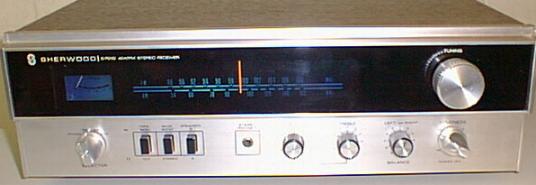
Above: Sherwood S-7310 (ca. 1974). The 7X10-series had a slimmer design than their predecessors in that the cabinets were pulled in behind the silver fronts. If you compare the S-7200 and the S-7310 you will note that the exterior facilities are much the same. The differences were inside. Better tuners, stronger amplifiers, less distortion. Above: The S-7010. The cheaper Sherwood receivers had just the same high quality materials and facilities as the more expensive models. The S-7010 was at the low-end of the scale as can be seen from the number of buttons. The tuner, however, was very high quality - as in all Sherwood models. Proportions same as the "larger" models. Power: Approx. 2x10 watts full-range into 8 ohms .
These were all made in Japan.

- Above: the S-2300 and S-3300 tuners. While the Allied catalogue of '67 contained no Sherwood units, the '68 catalogue featured no less than 6 different units in 3 categories: 2 receivers, 2 amplifiers and 2 tuners. We never imported these models as new models had taken over when we started to deal with Sherwood. That was the 7100-series upwards - a total break with the Sherwood tube era design, most of them being manufactured in Japan. While the integrated transistor amps continued in much the same exterior design as the tube units - mainly rocker switches taking over for the sliding switches, the receivers and tuners were rather different in that they got much larger, and off-set, tuning scales. The tradition of superior performance in the tuner sections was upheld.
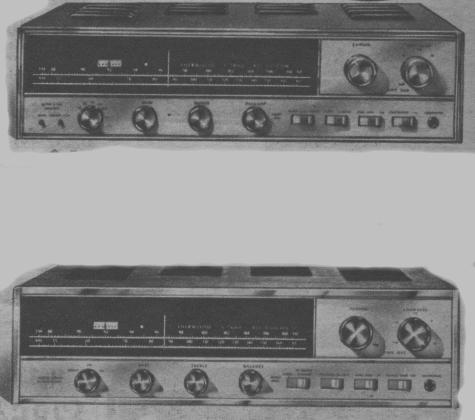
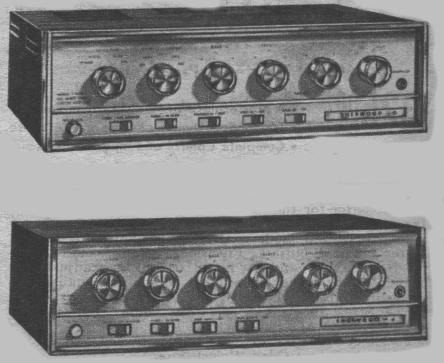
- Above left: The S-7800 and S-7600 receivers. These were supposedly the first totally solid-state receivers in the world! In the Allied '70 catalogue a new exterior receiver-design was introduced. This was to continue well into the seventies.
- Above right: The S-9500 and S-9900 integrated amplifiers. Main difference in exterior design of the integrated amplifiers was a switch-over to rocker switches instead of sliding switches. While in the "tube era" the Sherwood factory had kept to a "sound" policy regarding specifications on their units, in '68 they were on par with many other brands, in that figures were exaggerated. They came to their senses again in the beginning of the seventies.
- In the Allied '70 catalogue the suffix "B" was added to the S-9500. Also, the power output was raised from 80 to 100 watts. (Promotional watts, that is) At the bottom line it was quoted as yielding 2x30 watts. continous. Whether this was for 4 or 8 ohms impedance is not stated. Also, it was mentioned specifically (not in '68) that this amp had "overload protection fuses". Had they experienced blown output transistors on the earlier models, maybe?